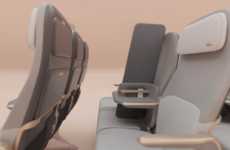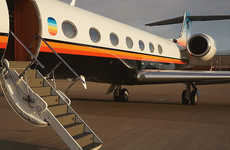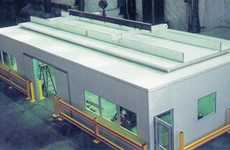
This Ebola Quarantine Jet Carries Ebola Victims Across Continents
Rahul Kalvapalle — August 6, 2014 — Autos
References: gulfstream & theatlantic
A designated Ebola quarantine jet is being used to carry victims of the virus from Africa to hospitals in the West, in order to prevent the spread of the infection to others. The airplane is a 32-year-old Gulfstream III that formerly belonged to the Danish Air Force.
What makes this airplane well-suited to quarantining patients of infectious disease is its speed -- it can travel long-haul routes at very high speeds even when carrying a large medical team in addition to the patient and the pilot.
This Ebola quarantine jet is also easily manipulable for the purpose of quarantining -- it was outfitted with an Aeromedical Biological Containment system, a tent-like plastic structure that uses a special ventilation system to keep pathogens contained inside.
What makes this airplane well-suited to quarantining patients of infectious disease is its speed -- it can travel long-haul routes at very high speeds even when carrying a large medical team in addition to the patient and the pilot.
This Ebola quarantine jet is also easily manipulable for the purpose of quarantining -- it was outfitted with an Aeromedical Biological Containment system, a tent-like plastic structure that uses a special ventilation system to keep pathogens contained inside.
Trend Themes
1. Ebola Quarantine Jets - The rise of designated jets specifically outfitted to carry infectious disease victims across continents presents opportunities for disruptive innovations in the aviation industry.
2. High-speed Quarantine Transportation - The use of high-speed airplanes for transporting infectious disease victims reduces travel time and potential exposure to others, creating opportunities for disruptive innovation in the transportation industry.
3. Aeromedical Biological Containment Systems - The development and implementation of specialized containment systems in aircrafts enables the safe transportation of infectious disease patients, offering opportunities for disruptive innovation in the healthcare and medical industry.
Industry Implications
1. Aviation - The aviation industry has the potential to disrupt traditional means of transportation by adopting designated jets for quarantining infectious disease victims.
2. Transportation - The transportation industry can explore the utilization of high-speed airplanes for the safe and efficient transportation of infectious disease victims.
3. Healthcare and Medical - The healthcare and medical industry can innovate by developing and implementing specialized containment systems in aircrafts for the secure transportation of infectious disease patients.
5
Score
Popularity
Activity
Freshness























